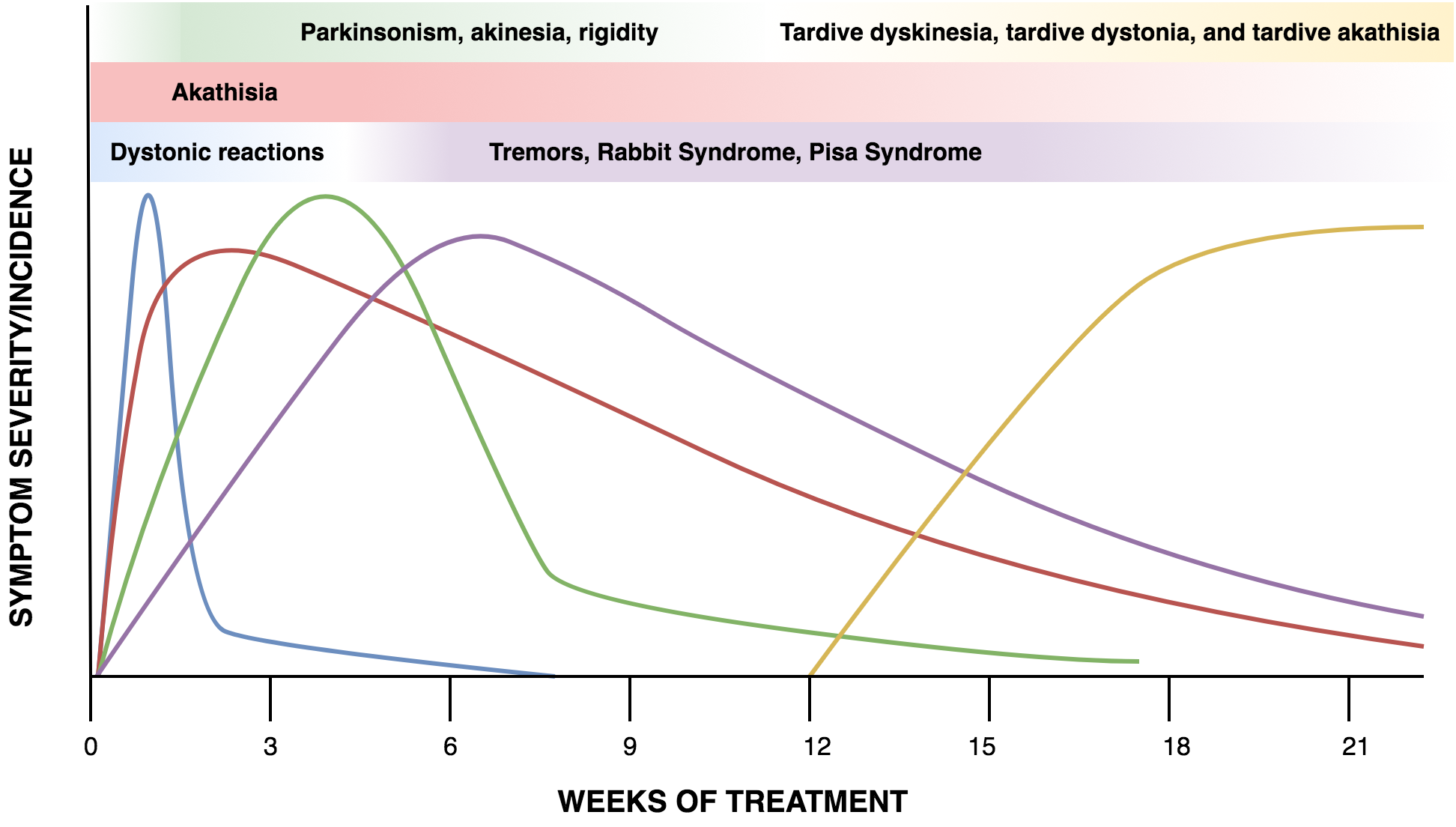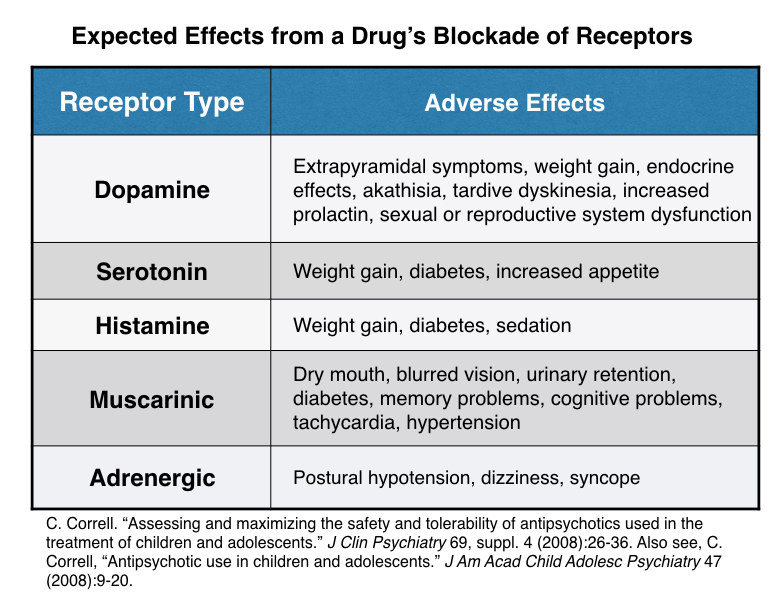Extrapyramidal Symptom Which Results by Prolonged Use of Antipsychotics
Causes of Tardive Dyskinesia. What symptoms may I have.

Neurological Side Effects Of Psychotropic Medications Psychiatric Annals
However it has been report.

. -Repetitive involuntary muscle movements of the faceneck most common blinking lip smacking tongue protrusion or rolling grimacing -The symptoms are IRREVERSIBLE can be. What are extrapyramidal symptoms. Extrapyramidal Side Effects from Antipsychotic Medications.
There is a lack of clinical studies of. Symptoms may be noticed after you take one dose of medicine or after long-term use. Asphyxia is one of the most serious types of antipsychotic-induced extrapyramidal symptoms.
May progress to the limbs irreversible condition may occur in months after antipsychotic medication use. Associated with prolonged use of antipsychotics. Tongue protrusion grimacing lip smacking Differential Diagnosis Movement Disorders and Other Abnormal Contractions.
However there are growing reports in the literature of antidepressant-induced EPS 39R. -Antipsychotic medications usually 3 months of medication administration OR. Extrapyramidal side effects EPS have been identified as a complication of antipsychotic treatment.
To study the prevalence course diagnostics and treatment of asphyxia and dysphagia caused by the use of antipsychotics. Hyperthermia muscle rigidity tremors. Atypical antipsychotics have lower D2 receptor affinity or higher serotonin 5-HT2A receptor affinity which lead to lower rates of EPS.
Extrapyramidal Symptoms EPS are drug-induced movement disorders that occur due to antipsychotic blockade of the nigrostriatal dopamine tracts. In studies with a control group that continued antipsychotic treatment only a proportion of 011 of individuals in the control group showed withdrawal symptoms compared to a proportion of 049 of individuals after abrupt antipsychotic discontinuation odds ratio 797 and NNH 3. On the other hand incidence of adverse events due to atypical antipsychotics is low.
A recent case report by Hutchins et al. Also given the broader use of antipsychotics in the mood and anxiety disorders choice of agent should reflect the risk of EPSEs and patients need to be fully informed in this regard. However stopping these medications may.
Vigilance for early signs and symptoms of EPSEs and prompt and effective management need still to be top of mind in the treatment of people with schizophrenia. Stereotyped repetitive facial movements eg. Extrapyramidal symptoms are most commonly caused by typical antipsychotic drugs that antagonize dopamine D2 receptors.
The relevant literature was retrieved via Medline 1960-2005 using combinations of the mesh terms antipsychotic agents dystonia. Hence this systematic review and meta-analysis was aimed to determine the magnitude of antipsychotic-induced EPSEs. EPS are serious sometimes debilitating and stigmatizing adverse effects and require additional pharmacotherapy.
Up to 10 cash back Akathisia ziprasidone 14 haloperidol 16 hypertonia ziprasidone 2 haloperidol 7 tremor ziprasidone 6 haloperidol 10 and extrapyramidal syndrome ziprasidone 1 haloperidol 5 were all reported less frequently with ziprasidone than with haloperidol. Extrapyramidal symptoms can affect how you move and tardive dyskinesia is one form of EPS that mostly affects your face. EPS include acute dystonias akathisia Parkinsonism and tardive dyskinesia TD.
Extrapyramidal symptoms EPS are side effects of antipsychotic medicines. Extrapyramidal symptoms EPS are movement disorders most commonly caused by exposure to dopamine-blocking medications such as antipsychotics 38R. Typical antipsychotics are easily expressed as adverse events such as extrapyramidal symptom EPS.
These blockades can lead to increased cholinergic activity resulting in acute dystonia acute akathisia antipsychotic-induced parkinsonism tardive dyskinesia TD tardive dystonia and tardive akathisia. EPS develop into two. Several studies were investigating the impact of the polymorphic cytochrome P450 2D6 gene CYP 2D6 on the psychopathological and extrapyramidal symptoms but the results were conflicting.
Extrapyramidal symptoms during long-term treatment with antipsychotics. The most common typical antipsychotics associated with EPS are haloperidol and fluphenazine. Both EPS and tardive dyskinesia are caused by antipsychotic medications.
Special focus on clozapine and D1 and D2 dopamine antagonists Neuropsychopharmacology. In this group family history and poor premorbid functioning appear to be associated with increased risk for movement disorders. These involuntary movements can be alarming and.
One of the most challenging problems in clinical psychiatry are inter-individual differences in clinical response to antipsychotic treatment. -Metoclopramide Reglan -Prochlorperazine Compazine Tardive Dyskinesia SS. Neuroleptic Malignant Syndrome NMS A potentially lethal side effect that requires emergency treatment.
Therefore currently atypical antipsychotics are widely used to treat schizophrenia. Extrapyramidal symptoms are a side effect of some medications such as antipsychotic drugs like dronabinol risperidone trandolapril and others. EPS can cause movement and muscle control problems throughout your body.
A variety of movement phenotypes has since been described along the EPS spectrum including dystonia akathisia. Antipsychotic medication use is frequently associated with unfavorable adverse effects such as extrapyramidal side effects EPSEs. Extrapyramidal side effects EPS commonly referred to as drug-induced movement disorders are among the most common adverse drug effects patients experience from dopamine-receptor blocking agents.
11 Clinical features TD is commonly characterised by lip smacking and chewing often with episodic tongue protrusion fly-. Previous meta-analyses have investigated EPS prevalence and risk factors in randomized clinical trials with highly selected patients but studies in real-world schizophrenia are missing. You may not be aware of these symptoms but others.
Available information was limited to studies with so-called first-generation. Continuing Education Activity. Discusses a 51 YOF with a history of PD MDD restless legs syndrome RLS hypertension.
Although antipsychotic exposure was associated with extrapyramidal signs the results indicate that many first-episode patients with no exposure to antipsychotics also had extrapyramidal dysfunction. The use of atypical antipsychotics as first line therapy for the treatment of schizophrenia is based largely on their reduced risk of EPS compared with conventional antipsychotics. TD generally occurs after long-term antipsychotic therapyTD is a complex neurological syndrome that consists of hyperkinetic involuntary movements which are mainly choreoathetoid but also dystonic in nature.

Pdf Second Generation Antipsychotics And Extrapyramidal Adverse Effects

Neurological Side Effects Of Psychotropic Medications Psychiatric Annals

Potential Clinical Efficacy And Benefits Related To The Mechanisms Of Download Table

Abnormal Movement Assessments And Side Effects Of Rlai And Fgai Therapy Download Table

Rx Of Schizophrenia Tusom Pharmwiki

Extrapyramidal Symptom Rating Scale N 50 Download Table

Extrapyramidal Symptoms Eps Psychdb

Psychotherapeutic Drugs Nursing Pharmacology Study Guide

Pdf Extrapyramidal Symptoms Probably Related To Risperidone Treatment A Case Series

Extrapyramidal Side Effects Of Antipsychotics Neura Library

Drug Info Antipsychotics Schizophrenia Mad In America

Implications Of Antipsychotic Use Nursing Clinics

Pdf Extrapyramidal Side Effects Of Antipsychotic Treatment Scope Of Problem And Impact On Outcome

Pdf Extrapyramidal Side Effects Of Antipsychotic Treatment Scope Of Problem And Impact On Outcome

Extrapyramidal Symptoms Invega Sustenna Hcp

Identification Assessment And Clinical Management Of Tardive Dyskinesia An Update

Switching Antipsychotics Why When And How

Pdf Extrapyramidal Side Effects Of Antipsychotic Treatment Scope Of Problem And Impact On Outcome

Comments
Post a Comment